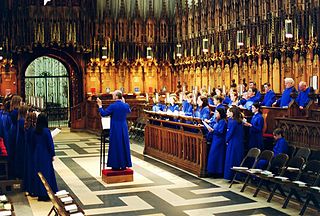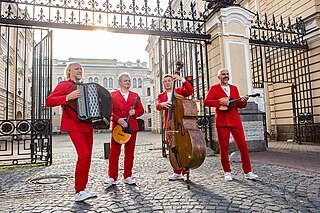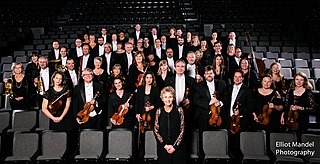
In Western classical music, a motet is mainly a vocal musical composition, of highly diverse form and style, from high medieval music to the present. The motet was one of the pre-eminent polyphonic forms of Renaissance music. According to Margaret Bent, "a piece of music in several parts with words" is as precise a definition of the motet as will serve from the 13th to the late 16th century and beyond. The late 13th-century theorist Johannes de Grocheo believed that the motet was "not to be celebrated in the presence of common people, because they do not notice its subtlety, nor are they delighted in hearing it, but in the presence of the educated and of those who are seeking out subtleties in the arts".

An orchestra is a large instrumental ensemble typical of classical music, which combines instruments from different families, including

Renaissance music is traditionally understood to cover European music of the 15th and 16th centuries, later than the Renaissance era as it is understood in other disciplines. Rather than starting from the early 14th-century ars nova, the Trecento music was treated by musicology as a coda to Medieval music and the new era dated from the rise of triadic harmony and the spread of the ' contenance angloise ' style from Britain to the Burgundian School. A convenient watershed for its end is the adoption of basso continuo at the beginning of the Baroque period.

A choir is a musical ensemble of singers. Choral music, in turn, is the music written specifically for such an ensemble to perform. Choirs may perform music from the classical music repertoire, which spans from the medieval era to the present, or popular music repertoire. Most choirs are led by a conductor, who leads the performances with arm, hand, and facial gestures.
An oratorio is a large musical composition for orchestra, choir, and soloists. Like most operas, an oratorio includes the use of a choir, soloists, an instrumental ensemble, various distinguishable characters, and arias. However, opera is musical theatre, while oratorio is strictly a concert piece – though oratorios are sometimes staged as operas, and operas are sometimes presented in concert form. In an oratorio, the choir often plays a central role, and there is generally little or no interaction between the characters, and no props or elaborate costumes. A particularly important difference is in the typical subject matter of the text. Opera tends to deal with history and mythology, including age-old devices of romance, deception, and murder, whereas the plot of an oratorio often deals with sacred topics, making it appropriate for performance in the church. Protestant composers took their stories from the Bible, while Catholic composers looked to the lives of saints, as well as to Biblical topics. Oratorios became extremely popular in early 17th-century Italy partly because of the success of opera and the Catholic Church's prohibition of spectacles during Lent. Oratorios became the main choice of music during that period for opera audiences.

A madrigal is a secular vocal music composition of the Renaissance and early Baroque (1600–1750) eras. The polyphonic madrigal is unaccompanied, and the number of voices varies from two to eight, but usually features three to six voices, whilst the metre of the madrigal varies between two or three tercets, followed by one or two couplets. Unlike the verse-repeating strophic forms sung to the same music, most madrigals are through-composed, featuring different music for each stanza of lyrics, whereby the composer expresses the emotions contained in each line and in single words of the poem being sung.

Terem Quartet is a musical ensemble from Saint Petersburg, Russia. The ensemble playing in the genre of Crossover was created in 1986. Since that time, Terem Quartet has released 17 CDs, and its repertoire includes more than 500 musical compositions of classical and modern music.

The Tallis Scholars is a British professional early music vocal ensemble normally consisting of two singers per part, with a core group of ten singers. They specialise in performing a cappella sacred vocal music.

During the reign of Queen Elizabeth I (1558–1603), English art and high culture reached a pinnacle known as the height of the English Renaissance. Elizabethan music experienced a shift in popularity from sacred to secular music and the rise of instrumental music. Professional musicians were employed by the Church of England, the nobility, and the rising middle-class.
The general discussion of how to perform music from ancient or earlier times did not become an important subject of interest until the 19th century, when Europeans began looking to ancient culture generally, and musicians began to discover the musical riches from earlier centuries. The idea of performing early music more "authentically", with a sense of incorporating performance practice, was more completely established in the 20th century, creating a modern early music revival that continues today.
Prince Andrei Mikhaylovich Volkonsky was a Russian composer of classical music and harpsichordist. He was a key figure in Early Music Revival in Russia.
In the years centering on 1600 in Europe, several distinct shifts emerged in ways of thinking about the purposes, writing and performance of music. Partly these changes were revolutionary, deliberately instigated by a group of intellectuals in Florence known as the Florentine Camerata, and partly they were evolutionary, in that precursors of the new Baroque style can be found far back in the Renaissance, and the changes merely built on extant forms and practices. The transitions emanated from the cultural centers of Northern Italy, then spread to Rome, France, Germany, and Spain, and lastly reached England . In terms of instrumental music, shifts in four discrete areas can be observed: idiomatic writing, texture, instrument use, and orchestration.
Lydia Anatolyevna Davydova was a Russian soprano, harpsichordist and a chamber music performer. As a singer her repertoire encompassed on one extreme the latest contemporary music, most particularly the music of Andrei Volkonsky, and on the other Renaissance and Early Baroque vocal music. Spending much of her life and career in Moscow, she was artistic director of the "Madrigal" early music ensemble and was decorated People's Artist of Russia (2001).
Giovanni Priuli was an Italian composer and organist of the late Renaissance and early Baroque periods. A late member of the Venetian School, and a contemporary of Claudio Monteverdi, he was a prominent musician in Venice in the first decade of the 17th century, departing after the death of his associate Giovanni Gabrieli and ending his career at the Habsburg court in Austria. His music straddled the dividing-line between Renaissance and Baroque idioms.

The Dubrovnik Summer Festival (Croatian: Dubrovačke ljetne igre; [dubrɔʋatʃkɛ ʎɛtnɛ iɡrɛ] is an annually-held summer festival instituted in 1950 in Dubrovnik, Croatia. It is held every year between 10 July and 25 August.
Renaissance Ensemble Serbia is the first early music ensemble in Serbia and the second in south-eastern Europe, having been founded in 1968. Ensemble Renaissance usually focuses on the music of the Middle ages, Renaissance and Baroque. Occasionally, however, Ensemble performs modern music on ancient instruments.
The Scholars is the name of an English a cappella group of four to five solo singers active 1968-2010, mainly in the field of classical music. In the United States they were also known as The Scholars of London and The Voices of London.

Music of the Baroque is an American professional chorus and orchestra based in Chicago, Illinois.
Marius van Altena, born Marius Hendrikus Schweppe is a Dutch tenor. He was one of the pioneers of historically informed performance of Baroque and Renaissance music. He has also sung Baroque opera, worked as conductor and as an academic teacher.









